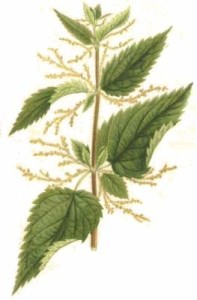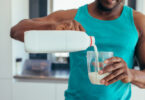Stinging Nettle (Urtica dioica L.) is a widespread plant and its roots and above ground parts are used in folk medicine against various diseases. Stinging nettle has been traditionally used to treat painful muscles and joints, eczema, arthritis, gout, and anemia. Today, many people use it to treat urinary problems during the early stages of an enlarged prostate
Dosage
Typical Stinging Nettle extract dosage is some where around 1.5 g daily divided into 500 mg doses. In studies evaluating its efficiency for diabetes, doses up to 100 mg/kg are used. Manufacturers typically recommend doses between 600 mg to 1.500 mg per day.
Lignan 3,4-Divanillyltetrahydrofuran
3,4-Divanillyltetrahydrofuran, also known as Divanil or 3,4-D, is a lignan found in Urtica dioica (Stinging nettle) and is of special interest in bodybuilding industry. Divanillyltetrahydrofuran may also be found in other lignan-containing plant sources such as flax-seed (Linum usitatissimum).[1]
Increased Free Testosterone (in vitro)
Testosterone in the human body exists in two forms, either free circulating or bound to transport proteins (inactive). The transport proteins to which sex hormones (such as testosterone, dihydrotestosterone and estradiol) bind are albumin and sex hormone binding globulin (SHBG) [2]. 3,4-Divanillyltetrahydrofuran binds itself to the SHBG with outstanding affinity (in vitro), thereby reducing the ability of SHBG to bind additional steroid hormones [3,4]. Actually, under experimental in vitro conditions 3,4-Divanillyltetrahydrofuran completely prevented dihydrotestosterone from binding to SHBG [4].
[the_ad id=”29483″]
Purity Issues
Divanillyltetrahydrofuran is used by some bodybuilders in an effort to increase free testosterone [5]. Though it was found that companies appear to have mislead consumers by marketing their divanil as being 95% pure. ThermoLife International conducted extensive tests, botanical analysis, and chromograph fingerprints which resulted in a purity of less than 5% 3,4-Divanillyltetrahydrofuran. Every known supplier and various products on the market labeled with 95% purity of 3,4-D were tested. All resulted with less than 5% 3,4-Divanillyltetrahydrofuran purity.[6]
A Case Report with 3,4-Divanillyltetrahydrofuran
3,4-Divanillyltetrahydrofuran has promising effects in vitro but lacks clinical trials [3]. However, there is one case report where 19 year-old male admitted that he was taking ActivaTe Xtreme™ (product containing Divanil)* after was found to have a high serum testosterone, and a raised luteinizing hormone. This biochemical pattern clearly shows that the boy didn’t fail to disclose steroid use due to raised luteinizing hormone which is suppressed with use of anabolic steroids (i.e. raised testosterone, suppressed luteinizing hormone and abnormal urine steroid profile) [5].
Studies have shown that 3,4-Divanillyltetrahydrofuran binds to SHBG [3], however no studies have been conducted to show that more free testosterone will be available. It probably works, but its binding to SHBG will (to some extent) also increase estrogen. So it would be wise to add estrogen blocker.
* Note: Old ActivaTe Xtreme was used.
Anti-Diabetic Activity
In glucose loaded rats, 250 mg/kg of aqueous extract of U. dioica had a significant antihyperglycemic effect which may be caused in part by the reduction of intestinal glucose absorption [9]. Another study in rats reported protective activity of the hydroalcholic extract of Urtica dioica leaves on β-cells in hyperglycemic rats [10]. It has also been reported to have a positive effect on cell density in the dentate gyrus (part of the hippocampus) of diabetic patients which may reduce cognitive impairment in the diabetic patient [11].
In patients with type-2 diabetes, hydro alcoholic extract of nettle has decreasing effects on interleukin 6 (IL-6) and hs-CRP high-sensitivity C-reactive protein (hs-CRP) [12] and increasing effects on total antioxidant capacity and superoxidant dismutase (enzymes that repairs cells and reduces the cellular damage) with no changes in malondialdehyde (MDA) and glutathione peroxides (GPX) [13].
Taking 500 mg nettle extract capsule every 8 hours for 3 months significantly lowered the blood levels of fasting glucose and glycosylated hemoglobin (HbA1c) [14].
The addition of nettle to diet may be possible and recommendable for the management of diabetes.
Other Uses of Stinging Nettle Extract
Although the evidence are insufficient stinging nettle root is used widely to treat benign prostatic hyperplasia (BPH). Studies in people suggest that stinging nettle, in combination with other herbs (especially saw palmetto), may be effective at relieving symptoms of the enlarged prostate gland. It is not known why nettle root reduces these symptoms. Scientists speculate that this may be due to chemicals contained in the plant that affect hormones (including testosterone and estrogen), or because it acts directly on prostate cells. [7] It is also not know if this benefit is due to stinging nettle, saw palmetto, or both ingredients.
Side Effects
Stinging nettle is non toxic and the risk for adverse events during nettle root treatment is very low [8].
[the_ad id=”29483″]
(Other common names: Common Nettle, Great Stinging Nettle, Nettle, Nettle Leaf, Nettle Seed, Nettle Worth, Nettles, Stinging Nettles, Urtica, Urtica urens, Divanil, 3,4-D)
References
-
Touré, Alhassane, and Xu Xueming. “Flaxseed Lignans: Source, Biosynthesis, Metabolism, Antioxidant Activity, Bio‐Active Components, and Health Benefits.” Comprehensive Reviews in Food Science and Food Safety 9.3 (2010): 261-269.
-
Schottner, M., D. Gansser, and G. Spiteller. “Interaction of lignans with human sex hormone binding globulin (SHBG).” Zeitschrift fur Naturforschung C-Journal of Biosciences 52.11 (1997): 834-843.
-
Schöttner, Matthias, Gerhard Spiteller, and Dietmar Gansser. “Lignans interfering with 5α-dihydrotestosterone binding to human sex hormone-binding globulin.” Journal of natural products 61.1 (1998): 119-121.
-
Schöttner, Matthias, Dietmar Ganßer, and Gerhard Spiteller. “Lignans from the roots of Urtica dioica and their metabolites bind to human sex hormone binding globulin (SHBG).” Planta medica 63.06 (1997): 529-532.
-
McDonald, Tim J., et al. “A novel case of a raised testosterone and LH in a young man.” Clinica Chimica Acta 412.21 (2011): 1999-2001.
- http://www.prweb.com/releases/2010/01/prweb3519384.htm. PRWeb. Retrieved Jan 29, 2013.
- Stinging Nettle – Retrieved from University of Maryland Medical Center at 29. April 2013
- Chrubasik, Julia E., et al. “A comprehensive review on the stinging nettle effect and efficacy profiles. Part II: urticae radix.” Phytomedicine 14.7 (2007): 568-579.
- Bnouham, Mohamed, et al. “Antihyperglycemic activity of the aqueous extract of Urtica dioica.” Fitoterapia 74.7 (2003): 677-681.
- Golalipour, Mohammad Jafar, and Vahid Khori. “The protective activity of Urtica dioica leaves on blood glucose concentration and beta-cells in streptozotocin-diabetic rats.” Pakistan journal of biological sciences: PJBS 10.8 (2007): 1200-1204.
- Jahanshahi, M., M. Golalipour, and M. Afshar. “The effect of Urtica dioica extract on the number of astrocytes in the dentate gyrus of diabetic rats.” Folia Morphologica 68.2 (2009): 93-92.
- Namazi, N., et al. “The effect of hydro alcoholic Nettle (Urtica dioica) extracts on insulin sensitivity and some inflammatory indicators in patients with type 2 diabetes: a randomized double-blind control trial.” Pakistan journal of biological sciences: PJBS 14.15 (2011): 775-779.
- Namazi, N., A. Tarighat, and A. Bahrami. “The effect of hydro alcoholic nettle (Urtica dioica) extract on oxidative stress in patients with type 2 diabetes: a randomized double-blind clinical trial.” Pakistan journal of biological sciences: PJBS 15.2 (2012): 98-102.
- Kianbakht, Saeed., et al. “Improved glycemic control in patients with advanced type 2 diabetes mellitus taking Urtica dioica leaf extract: a randomized double-blind placebo-controlled clinical trial.” Clin Lab 59.9-10 (2013): 1071-1076.




